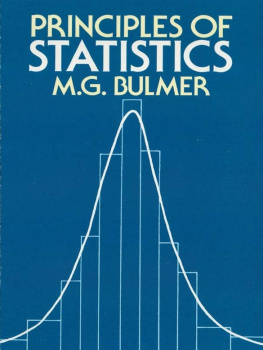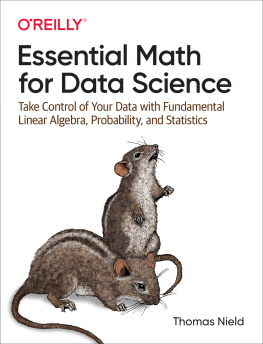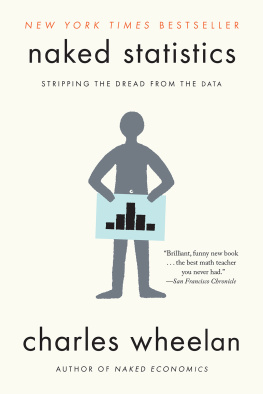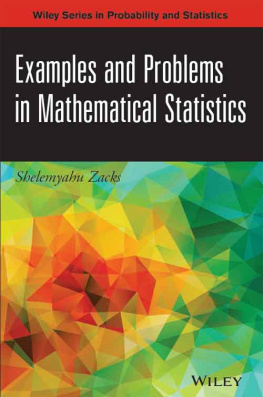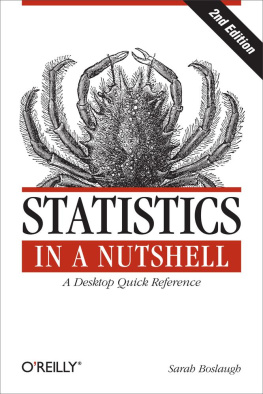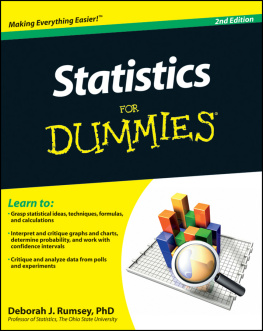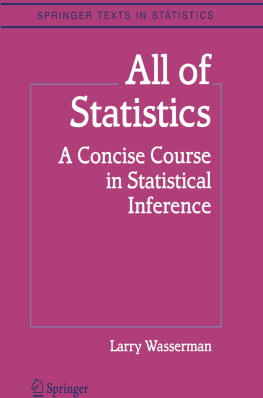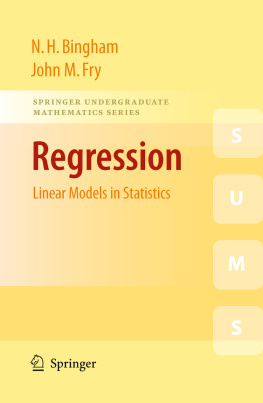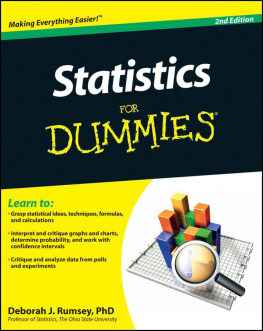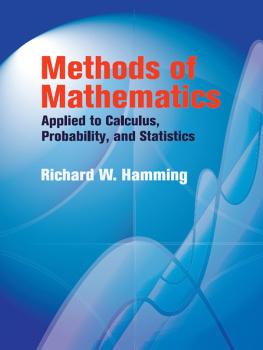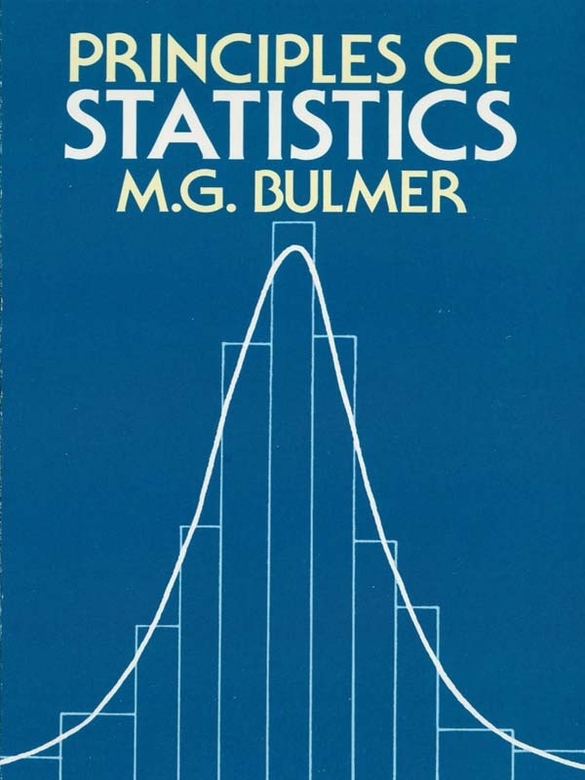REFERENCES
BAILEY, N. T. J. 1951. Biometrika , , 293.
1959. Statistical Methods in Biology . E.U.P., London.
1964. The Elements of Stochastic Processes with applications to the Natural Sciences . Wiley, New York.
BARTLETT, M. S. 1960. Stochastic Population Models . Methuen, London.
BATESON, W. 1909. Mendels Principles of Heredity . University Press, Cambridge. (Contains a translation of Mendels papers.)
BAYES, T. 1763. Phil. Trans. Roy. Soc ., , 370. (Reproduced 1958, in Biometrika , , 293.)
BERKSON, J. 1938. J. Amer. Statist. Ass ., , 526.
BERKSON, J., MAGATH, T. B. and HURN, M. 1935. J. Amer. Statist. Ass., , 414.
BERNOULLI, J. 1713. Ars conjectandi, opus posthumum . Basle.
BLACKWELL, D. and GIRSHICK, M. A. 1954. Theory of Games and Statistical Decisions . Wiley, New York.
BORTKIEWICZ, L. VON. 1898. Das Cesetz der kleinen Zahlen . Leipzig.
BOWEN, M. G. 1947. J. Agric. Res ., 75, 259.
BRAITHWAITE, R. B. 1955. Scientific Explanation . University Press Cambridge.
BROWN, B. H. 1919. Amer. Math. Monthly , , 351.
BUTLER, V. J. 1961. In Anglo-Saxon Coins , pp. 195-214, ed. R. H. M. Dolley. Methuen, London.
CARNAP, R. 1950. Logical Foundations of Probability . Routledge and Kegan Paul, London.
CHAMBERLAIN, A. C. and TURNER, F. M. 1952. Biometrics, , 55.
CHERNOFF, H. and MOSES, L. E. 1959. Elementary Decision Theory . Wiley, New York.
COTTON, C. 1674. The Compleat Gamester .
COURANT, R. 1934. Differential and Integral Calculus . Blackie, London & Glasgow.
CZUBER, E. 1903. Wahrscheinlichkeitsrechnung und ihre Anwendung auf Fehlerausgleichung, Statistik und Lebensversicherung , Leipzig.
DE MOIVRE, A. 1733. Approximatio ad Summam Terminorum Binomii ( a + b ) n in Seriem expansi. A translation by de Moivre is reproduced in D. E. Smiths Source Book in Mathematics (McGraw-Hill, 1929).
FATT, P. and KATZ, B. 1952. J. Physiol ., , 109.
FERRAR, W. L. 1941. Algebra . University Press, Oxford.
FISHER, R. A. 1915. Biometrika , , 507.
1921. Metron , , Part 4, p. 3.
1924. Proc. Int. Math. Congress , Toronto, p. 805.
1925. Statistical Methods for Research Workers . Oliver & Boyd, Edinburgh.
1925. Metron , , 90.
1935. Ann. Eugen ., , 391.
1956. Statistical Methods and Scientific Inference . Oliver & Boyd, Edinburgh.
FISHER, R. A. and YATES, F. 1953. Statistical Tables for Biological, Agricultural and Medical Research . (4th edn.) Oliver & Boyd, Edinburgh.
GALTON, F. 1889. Natural Inheritance . (1st edn.) Macmillan, London.
GAUSS, C. F. 1809. Theoria Motus Corporum Coelestium . Hamburg.
GEISSLER, A. 1889. Z.K. schsischen statistischen Bureaus, 35, 1.
GREENWOOD, A. W., BLYTH, J. S. S. and CALLOW, R. K. 1935. Biochem . J ., , 1400.
GREENWOOD, M. and YULE, G. U. 1920. Jour. Roy. Stat. Soc ., , 255.
HARRIS, H. and KALMUS, H. 1949. Ann. Eugen ., 15, 24.
HARTMANN, G. 1939. Ann. Eugen ., , 123.
HELMERT, F. R. 1876. Zeit. fr Math. und Phys ., , 192. 1876. Astronomische Nachrichten , , No. 2096.
HUFF, D. 1960. How to Take a Chance . Gollancz, London.
JEFFREYS, H. 1961. Theory of Probability . (3rd edn.) University Press, Oxford.
KERRICH, J. E. 1946. An Experimental Introduction to the Theory of Probability . Munksgaard, Copenhagen.
KEYNES, J. M. 1921. A Treatise on Probability . Macmillan, London.
KING, H. D. 1924. Anat. Record , , 337.
LAPLACE. 1812. Thorie analytique des Probabilits , Paris. 1814. Essai Philosophique sur les Probabilits . (English translation by Truscott & Emory (1902), reprinted 1951 by Dover Publications.)
LATTER, O. H. 1901. Biometrika , , 69.
LURIA S. E. AND DELBRCK, M. 1943. Genetics , 28, 491.
MACDONELL, W. R. 1901. Biometrika , , 177.
McKINSEY, J. 1952. Introduction to the Theory of Games . McGraw-Hill, New York.
MARSDEN, E. and BARRATT, T. 1911. Proc. Phys. Soc ., 23, 367.
MENDEL, G. See BATESON, 1909.
MISES, R. VON. 1957. Probability, Statistics and Truth . Allen and Unwin, London.
NAIR, A. N. K. 1941. Sankhy , 5, 383.
PEARSON, K. 1900. Phil. Mag ., 50, 157.
PEARSON, K. and LEE, A. 1903. Biometrika , , 357.
POINCAIR, H. 1896. Calcul des Probabilits . Gauthier-Villars, Paris.
POISSON, S. D. 1837. Recherches sur la probabilit des Jugements en Matire Criminelle et en Matire Civile . Paris.
QUETELET, L. A. J. 1835. Essai de Physique Sociale . Bruxelles.
RAMSEY, F. P. 1931. The Foundations of Mathematics and other Logical Essays . Routledge and Kegan Paul, London and New York.
REICHENBACH, H. 1949. The Theory of Probability . University of California Press, Los Angeles.
RUTHERFORD, E., GEIGER, H. and BATEMAN, H. 1910. Phil. Mag ., , 698.
SAVAGE, L. J. 1954. The Foundations of Statistics . Wiley, New York.
SIEGEL, S. 1956. Non-parametric Statistics . McGraw-Hill, New York.
SINNOTT, E. W. 1937. Proc. Nat. Acad. Sci . Wash ., 23, 224.
SMITH, D. A. 1929. A Source Book in Mathematics . McGraw-Hill, New York.
STUDENT. 1907. Biometrika , , 351.
STUDENT. 1908. Biometrika , , 1.
THOMPSON, W. DARCY. 1917 (1st edn.) (2nd edn. 1942. reprinted 1952) On Growth and Form . University Press, Cambridge.
WALD, A. 1939. Ann. Math. Stat. , , 299. 1950. Statistical Decision Functions . Wiley, New York.
WEINER, J. S. 1955. The Piltdown Forgery . University Press, Oxford.
WILLIAMS, E. J. 1959. Regression Analysis. Wiley, New York.
WILLIAMS, J. D. 1954. The Compleat Strategyst. McGraw-Hill, New York.
YULE, G. U. and KENDALL, M. G. 1950. An Introduction to the Theory of Statistics . (14th edn.) Griffin, London.
CHAPTER 1
THE TWO CONCEPTS OF PROBABILITY
But glory doesnt mean a nice knock-down argument , Alice objected.
When I use a word, Humpty Dumpty said, in rather a scornful tone, it means just what I choose it to meanneither more nor less.
The question is, said Alice, whether you can make words mean so many different things.
The question is, said Humpty Dumpty, which is to be masterthats all.
Lewis Carroll: Through the Looking-glass
It is advisable in any subject to begin by defining the terms which are to be used. This is particularly important in probability theory, in which much confusion has been caused by failure to define the sense in which the word probability is being used. For there are two quite distinct concepts of probability, and unless they are carefully distinguished fruitless controversy can arise between people who are talking about different things without knowing it. These two concepts are: (1) the relative frequency with which an event occurs in the long run, and (2) the degree of belief which it is reasonable to place in a proposition on given evidence. The first of these I shall call statistical probability and the second inductive probability, following the terminology of Darrell Huff (1960). We will now discuss them in turn. Much of this discussion, particularly that of the logical distinction between the two concepts of probability, is based on the excellent account in the second chapter of Carnap (1950).
STATISTICAL PROBABILITY
The concept of statistical probability is based on the long run stability of frequency ratios. Before giving a definition I shall illustrate this idea by means of two examples, from a coin-tossing experiment and from data on the numbers of boys and girls born.
Coin-tossing. No one can tell which way a penny will fall; but we expect the proportions of heads and tails after a large number of spins to be nearly equal. An experiment to demonstrate this point was performed by Kerrich while he was interned in Denmark during the last war. He tossed a coin 10,000 times and obtained altogether 5067 heads; thus at the end of the experiment the proportion of heads was 5067 and that of tails 4933. The behaviour of the proportion of heads throughout the experiment is shown in . It will be seen that it fluctuates widely at first but begins to settle down to a more or less stable value as the number of spins increases. It seems reasonable to suppose that the fluctuations would continue to diminish if the experiment were continued indefinitely, and that the proportion of heads would cluster more and more closely about a limiting value which would be very near, if not exactly, one-half. This hypothetical limiting value is the (statistical) probability of heads.

